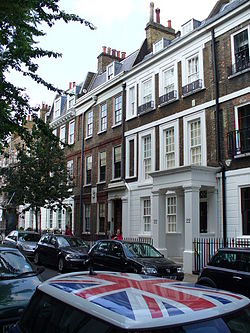Carlyle's House
| Carlyle's House | |
|
National Trust | |
|---|---|
 Carlyle's House on Cheyne Row | |
| Grid reference: | TQ271777 |
| Information | |
| Website: | Carlyle's House |
Carlyle's House stands at 24 Cheyne Row, Chelsea in Middlesex. This was the London home acquired by the historian, philosopher and essayist Thomas Carlyle and his wife Jane Welsh Carlyle, who had hitherto lived at Craigenputtock in Dumfriesshire.
Jane Welsh was a prominent woman of letters in her own right for nearly half a century, and the Carlyles were leading lights of the enlightenment. Samuel Butler though said of them "It was very good of God to let Carlyle and Mrs Carlyle marry one another and so make only two people miserable instead of four."[1]
The building dates from 1708. Today it is No. 24 Cheyne Row; it was No. 5 at Carlyle's time. The house is now owned by the National Trust.
Architecture
The house is a typical Georgian terraced house, a modestly comfortable home where the Carlyles lived with one servant and Jane's dog, Nero. The house was opened to the public in 1895, just fourteen years after Carlyle's death. It is preserved very much as it was when the Carlyles lived there despite another resident moving in after them with her scores of cats and dogs. It is a good example of a middle class Victorian home due to the efforts of devotees tracking down much of the original furniture owned by the Carlyles. It contains some of the Carlyles' books (many on permanent loan from the London Library, which was established by Carlyle), pictures and personal possessions, together with collections of portraits by artist such as James Abbott McNeill Whistler and Helen Allingham and memorabilia assembled by their admirers.
The house is made up of four floors — a basement which houses the kitchen, the ground floor which was the Carlyles' parlour, the first floor where the drawing room/library and Jane's bedroom are found, the second floor which was Thomas's bedroom and is now the Custodian's residence, and the attic, which was converted into a study in an attempt to remove Carlyle from the constant noise of the street and neighbours. It has a small walled garden which is preserved much as it was when Thomas and Jane lived there — the fig tree still produces fruit today.
See also
Outside links
- Carlyle's House - National Trust
References
- ↑ Samuel Butler, Letter to Eliza Savage, 21 November 1884, quoted in Letters between Samuel Butler and E.M.A. Savage, 1871-1885 (1935)